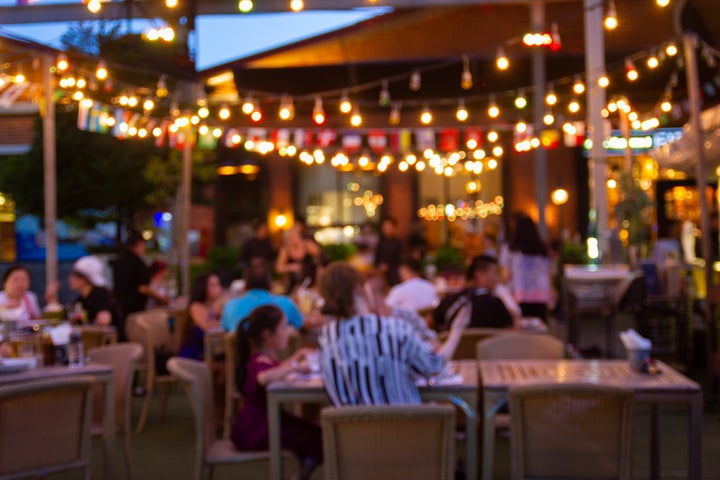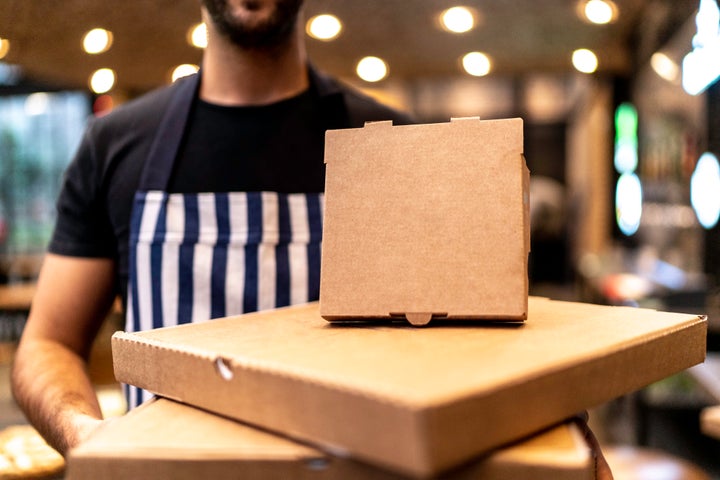Dining in an igloo-like bubble on the sidewalks of New York City is probably not something anyone predicted doing in 2020. But that’s just one of the many ways businesses have had to pivot in this COVID-19 world. Restaurants have been hit hard by the pandemic ― according to the National Restaurant Association, it’s estimated that 100,000, or 1 in 6, restaurants in the U.S. closed six months into the global pandemic. The service industry is projected to lose $240 billion in 2020.
Moving into 2021, there’s no doubt the industry will continue to change and adapt new measures to stay afloat. That can include increased prices, virtual experiences and even noticeable differences in the age of servers. HuffPost spoke to industry insiders, chefs and owners to find out what they’re predicting we’ll see in the new year and beyond.
Beautified outdoor dining spaces
Some restaurants have had the privilege and square footage to set up outdoor dining areas. But more establishments will have to work extra hard to set the proper atmosphere so diners don’t just feel like they’re having a meal on the sidewalk or a parking lot, said Dan Rowe, the CEO of Fransmart, a franchise development company behind the likes of Five Guys, The Halal Guys and more.
It’s key to have “an outdoor area that looks and feels like inside,” he told HuffPost. He cited celebrity-favorite Brooklyn Chop House in New York as an example, as the restaurant was “able to convert several outdoor parking spaces into tented and heated seating that still very much feels clubby, hip, and on-brand.”

Making the outside both look and feel like the inside will continue to be key for many restaurants — and it’s easier said than done. Even basics like canopies and heaters can eat up a chunk of money.
“Business will be slower as fewer diners will want to brave the cold weather to have a meal,” said Shanny Covey, owner of Robin’s in Cambria, California, and Luna Red, which has been a San Luis Obispo staple for a decade. “Restaurants will have to do the math to figure out if it’ll be worth [it] to stay open for dine in.”
A noticeable change in what staff looks like
There’s no dining ― inside, outdoors or takeout ― without a dedicated staff. The restaurant industry has been friendly to younger employees who may be less experienced or in need of a flexible schedule, but Matt Greene, executive chef of Common House in Charlottesville and Richmond, Virginia, said this might change.
“I think we’ll see fewer younger service professionals entering the industry,” he said. “The restaurant industry won’t hold the same appeal of easy money in a fun, fast-paced environment. Until we’re on the other end of the pandemic, the work will be characterized by greater output for a lower return.”
But Carole MacDonal of La Cosecha Bar + Restaurant and Il Cortile Ristorante, both in Paso Robles, also sees the current industry being less than appealing for some older, more experienced pros.
“I do find the ‘veterans’ are burning out at a faster rate than younger servers. We are experiencing a few older, experienced employees leaving the business altogether and going toward employment that does not have anything to do with customer service,” said MacDonal, whose restaurants have collectively been in business for almost two decades.
Say goodbye to automatic surcharges, and hello to menu increases
Earlier in the pandemic, there was talk about restaurants adding a COVID-19 surcharge to recoup expenses. These received mixed responses, and everyone we talked to agreed surcharges are probably something we’ll see less and less of.
“Customers don’t like being talked at,” Rowe said about automatic charges that can discourage people from supporting a restaurant. MacDonal agreed: “I would love to add a small COVID-19 surcharge to every check to cover the cost of propane alone, but in places that have tried, it is not well-accepted.”
But that doesn’t mean customers won’t see some prices going up in other ways.
“I think the best way to help the additional costs is to raise prices a small amount to cover those costs,” MacDonal said. These increases allow restaurants to cover some expenses without drawing so much overt attention to forced charges.
Menu items will reflect the climate, literally and figuratively
Staff turnover and price increases might be pretty obvious, but some experts also see a change in what foods people gravitate toward.
“Guests have consistently steered away from adventurous or unfamiliar foods,” Greene said. “The general dining public wants to be comfortable. They want to know what they are getting and they want it to feel good. No education or thinking required.”

He also noted that restaurants, particularly those offering outdoor dining, will have to adapt menus so they offer foods that are well-suited to colder climates — things like stews and soups, but also grits, tamales, polenta, baked pasta and braised lamb shanks.
“The menus will also need to offer food that holds temperature for longer as well as food that warms the body and soul,” Greene said. “Ideally you’re looking for a reasonably high water content and a high fat content. The fat plays a big part in holding the heat.”
Takeout and delivery will cost restaurants more money
Some cities have shut down indoor dining or limited occupancy, and some people just don’t feel comfortable dining inside. Takeout and delivery will continue to be important, but require extra costs and creativity.
Establishments that may have previously focused on in-house dining will have no choice but to factor in the expense of to-go orders, Rowe said.
“It’s a new line item in the [profit and loss] that needs to be taken seriously and highly focused on,” he said of the additional, but now necessary, costs of providing meals and packaging that still feels in line with the brand.

“Takeout and ghost kitchens will continue to thrive and it will be a significant revenue stream for all restaurants, so it will be important to embrace this trend out of necessity,” Covey said.
But she noted this will mean more waste and even more money.
“I strongly believe that restaurants need to take the lead in using more sustainable options for takeout,” she said. “The conflict with this decision is that eco-friendly packaging is more expensive and restaurants are already having to shoulder the burden of much higher costs for [PPE] supplies.”
In addition to restaurants crunching the numbers, she said, there might be a push for collaboration or education from local waste companies on proper ways to reduce, reuse and recycle.
Virtual experiences that foster a connection
And finally, for the people who want a dining experience in their own home, establishments may lean in to selling pre-packaged kits for virtual events.
Common House has regular virtual events like cookie decorating classes and whisky tastings. Members of the social club pick up what they need for the event ahead of time.
“Accessibility, comfort and perceived value are where the trends are headed,” Greene said.
These virtual gatherings also allow customers to have contact, albeit virtual, with chefs and owners who may have typically remained behind the scenes. One of Greene’s favorite events was a pizza class he taught from his personal kitchen.
“My wife, two kids and the dog were all there,” he said. “It felt like hosting a family pizza night, tantrums and burnt tongues included. The imperfections and real-life glimpses into everyone’s homes and lives made it incredibly authentic.”